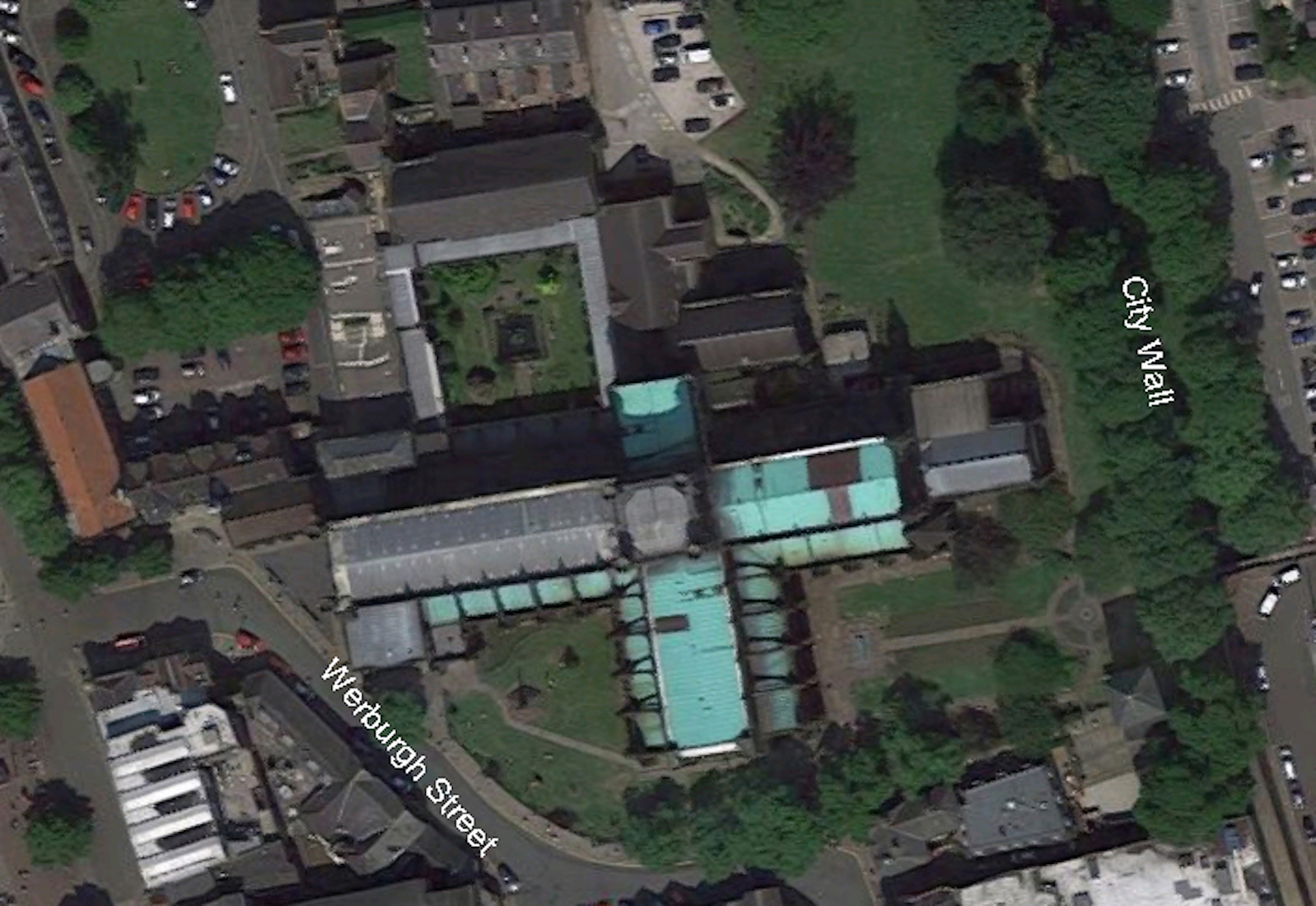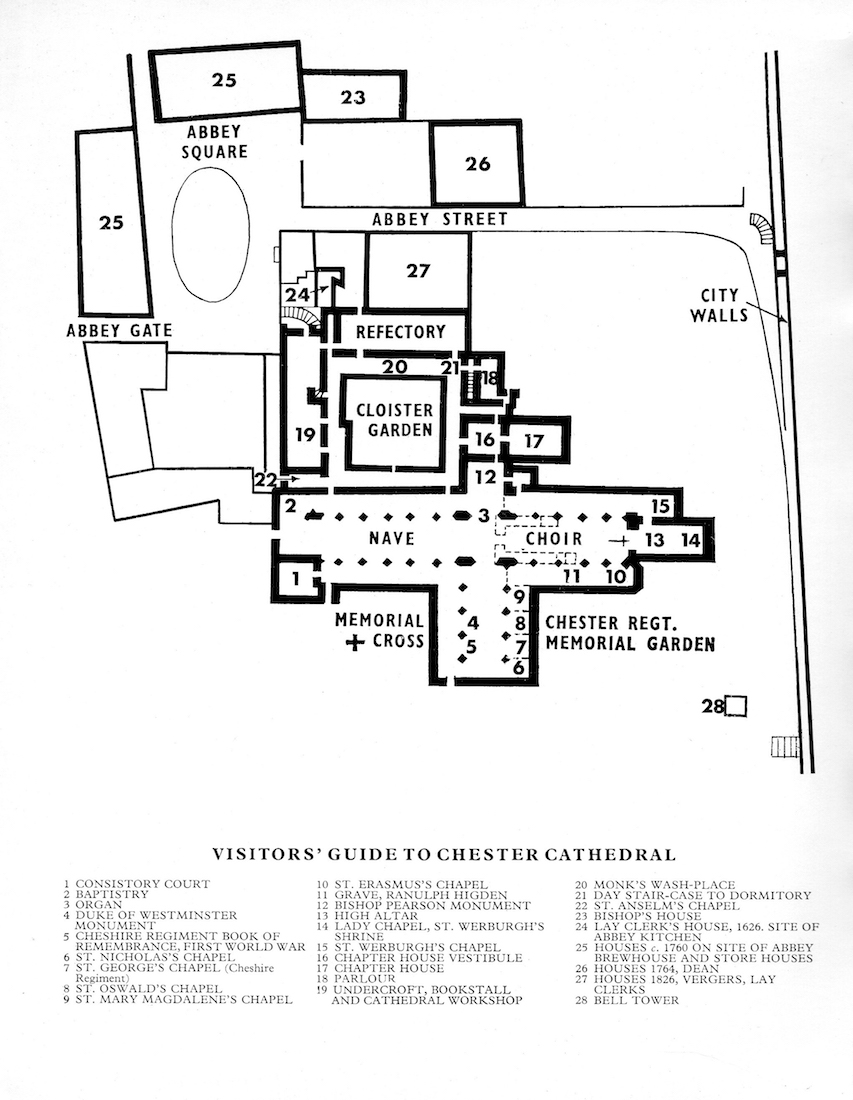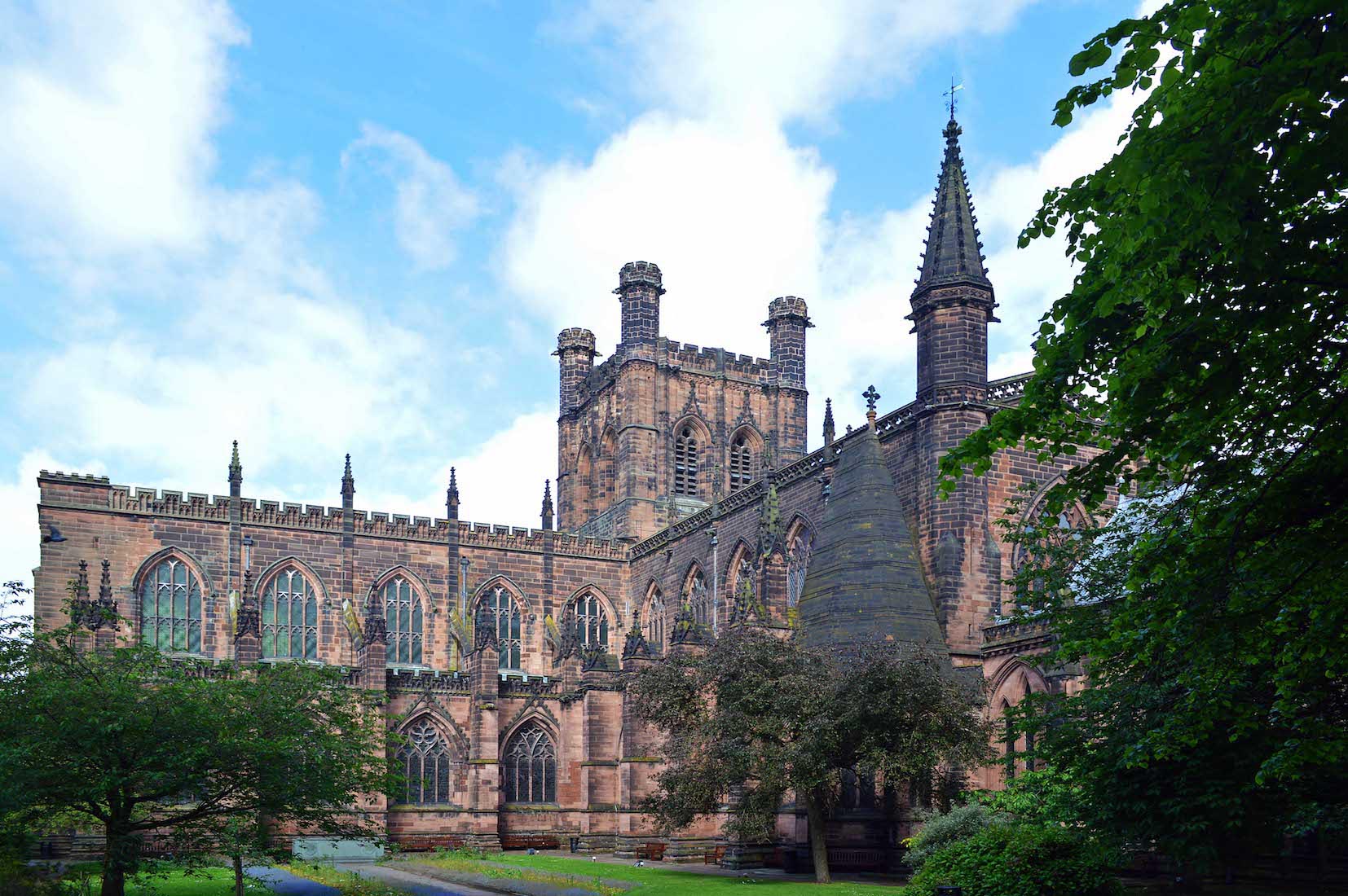CHESTER CATHEDRAL
CHESHIRE ENGLAND
PAUL SCOTT

SATELLITE VIEW
The satellite view shows the Cathedral in a pleasant park setting, bounded by the city wall. The Cathedral is essentially cruciform in shape, except that one arm of the Cross is truncated. The cloisters, the central tower, the Lady Chapel (at right) and the chapter house are all clearly visible. The Cathedral is sited with its main axis almost exactly due east-west, so we can assume that our geographical and liturgical directions coincide.

Chester is a very old Cathedral. The numbers on this Cathedral plan refer to the notes below. However, we shall begin our tour at the West door (left), circumnavigate the outside of the Cathedral in an anticlockwise direction, and then explore the interior. There are several unique features of Chester Cathedral. The cloisters are all glazed with stained glass, making a photographic record quite a task! The North transept [12] is extremely small, being bounded by the cloisters and the chapter house. And the South Quire aisle [11] is unexpectedly short. This is a very interesting Cathedral to explore.
A short history of the Cathedral follows. Or you can go straight to the Cathedral by clicking / tapping on START .
You can also access intermediate points in the tour by a tap / click on the following links:
START 01
To continue, start with START!
NOTE ON MAGNIFYING IMAGES
With this website format the images are large enough for most purposes. If there is a need for greater magnification of an image, go to the identical photo on
https://www.flickr.com/photos/paulscottinfo/albums
and use Command - + (Mac) or Windows - + (Windows).
HISTORY
[WIkipedia]
The city of Chester was an important Roman stronghold. There may have been a Christian basilica on the site of the present Cathedral in the late Roman era, while Chester was controlled by Legio XX Valeria Victrix. Legend holds that the basilica was dedicated to Saint Paul and Saint Peter. This is supported by evidence that in Saxon times the dedication of an early chapel on this site was changed from Saint Peter to Saint Werburgh. During the Early Middle Ages Barloc of Norbury, a Catholic Celtic saint and hermit, was venerated at Chester Cathedral with a feast day on 10 September. He is known to history mainly through the hagiography of the Secgan Manuscript; he also occurs in a litany in MS Tanner 169* of the Bodleian Library, Oxford. In 907 Chester was refortified against the threat from the Vikings, and shortly afterwards the minster was founded or refounded, and Werburgh’s remains were transferred there from Hanbury, probably by Æthelflæd, Lady of the Mercians. The collegiate church, as it was then, was restored in 1057 by Leofric, Earl of Mercia and Lady Godiva. This church was razed to the ground around 1090, with the secular canons evicted, and no known trace of it remains. In 1093 a Benedictine abbey was established on the site by Hugh Lupus, Earl of Chester, with the assistance of St Anselm and other monks from Bec in Normandy. The earliest surviving parts of the structure date from that time. The abbey church was not at that time the cathedral of Chester; from 1075 to 1082 the cathedral of the diocese was the nearby church of St John the Baptist, after which the see was transferred to Coventry.
In 1538, during the dissolution of the monasteries, the monastery was disbanded and the shrine of Saint Werburgh was desecrated. In 1541 St Werburgh’s abbey became a cathedral of the Church of England, by order of Henry VIII. At the same time, the dedication was changed to Christ and the Blessed Virgin. The last abbot of St Werburgh’s Abbey, Thomas Clarke, became the first dean of the new cathedral, at the head of a secular chapter. Although little trace of the 10th-century church has been discovered, save possibly some Saxon masonry found during a 1997 excavation of the nave, there is much evidence of the monastery of 1093. This work in the Norman style may be seen in the Northwest tower, the North transept and in remaining parts of the monastic buildings. The abbey church, beginning with the Lady Chapel at the Eastern end, was extensively rebuilt in Gothic style during the 13th and 14th centuries.
At the time of the dissolution of the monasteries, the cloister, the central tower, a new South transept, the large West window and a new entrance porch to the South had just been built in the Perpendicular style, and the Southwest tower of the façade had been begun. The West front was given a Tudor entrance, but the tower was never completed. In 1636 the space beneath the Southwest tower became a bishop’s consistory court. It was furnished as such at that time, and is now a unique survival in England, hearing its last case, that of an attempted suicide of a priest, in the 1930s. Until 1881, the south transept, which is unusually large, also took on a separate function as an independent ecclesiastical entity: the parish church of St Oswald.
Although the 17th century saw additions to the furnishings and fittings, there was no further building work for several centuries. By the 19th century, the building was badly in need of restoration. The present homogeneous appearance that the cathedral presents from many exterior angles is largely the work of Victorian restorers, particularly George Gilbert Scott. The 20th century has seen continued maintenance and restoration. In 1922, the Chester War Memorial was installed in the Cathedral grounds and dedicated to the fallen soldiers of the First World War and later the Second World War. In 1973 – 75 a detached belfry, the Addleshaw Tower, designed by George Pace, was erected in the grounds of the cathedral. In 2005 a new Song School was added to the Cathedral. During the 2000s, the Cathedral library was refurbished and relocated. It was officially reopened in September 2007. The Cathedral and the former monastic buildings were designated as Grade I listed buildings on 28 July 1955.



